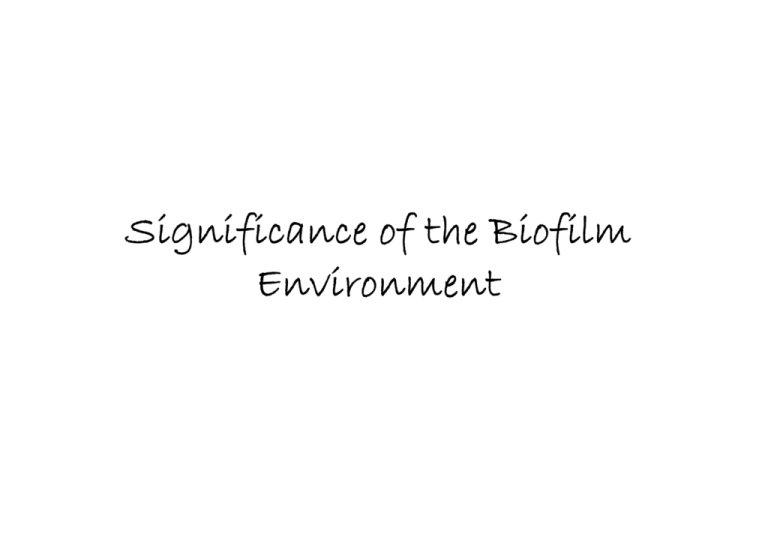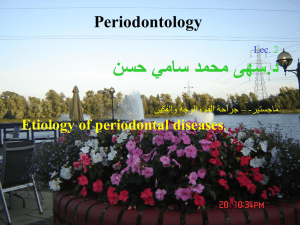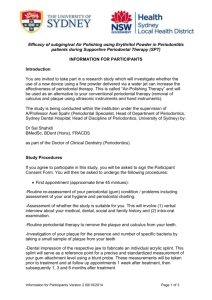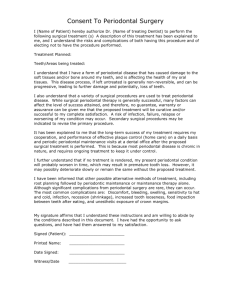periodontal microbiology
advertisement

Significance of the Biofilm Environment • Studies of oral microbial communities as biofilms in vitro further highlight the significance of structural and physiologic interactions between bacterial species in plaque. • Recent analyses of more than 13,000 plaque samples of 40 subgingival microorganisms using a DNAhybridization methodology was used to define “complexes” of periodontal microorganisms. • The composition of the different complexes is based on the frequency with which microorganisms are recovered together. Interestingly, the early colonizers are either independent of defined complexes (A. naeslundii, A. viscosus) or members of the yellow (Streptococcus spp.) or purple complexes (A. odontolyticus) • The microorganisms primarily considered secondary colonizers fell into the green, orange or red complexes. • The Green complex includes E. corrodens, Actinobacillus actinomycetemcomitans serotype a, and Capnocytophaga spp. • The Orange complex includes Fusobacterium, Prevotella, and Campylobacter spp. The green and orange complexes include species recognized as pathogens in periodontal and nonperiodontal infections. • The Red complex consists of P. gingivalis, B. forsythus, and T. denticola. The red complex is of particular interest because it is associated with bleeding on probing, which is an important clinical parameter of destructive periodontal diseases. ASSOCIATION OF PLAQUE MICROORGANISMS WITH PERIODONTAL DISEASES Microbial Specificity of Periodontal Diseases • In the mid-1900s, periodontal disease was believed to result from an accumulation of plaque over time in conjunction with a diminished host response and increased host susceptibility with age. • However, several observations contradicted these conclusions. First, some individuals with considerable amounts of plaque and calculus, as well as gingivitis, never developed destructive periodontitis. Nonspecific Plaque Hypothesis • The nonspecific plaque hypothesis maintains that periodontal disease results from the “elaboration of noxious products by the entire plaque flora.” • According to this thinking, small amounts of plaque are present, the noxious products are neutralized by the host. Similarly, large amounts of plaque would produce large amounts of noxious products, which would essentially overwhelm the host's defenses. Inherent in the nonspecific plaque hypothesis is the concept that control of periodontal disease depends on control of the amount of plaque accumulation. Specific Plaque Hypothesis • The specific plaque hypothesis states that only certain plaque is pathogenic, and its pathogenicity depends on the presence of or increase in specific microorganisms. • Acceptance of the specific plaque hypothesis was spurred by the recognition of A. actinomycetemcomitans as a pathogen in localized aggressive periodontitis. These advances led to a series of association studies focused on identifying specific periodontal pathogens by examining the microbiota associated with states of health and disease in cross-sectional and longitudinal studies. Microorganisms Associated with Specific Periodontal Diseases • The microbiota associated with periodontal health and disease has been studied with a wide variety of techniques for sampling, cultivation, and/or detection of bacteria by DNA hybridization. • Further, the classification of periodontal diseases has undergone a number of changes during the time that association studies have been conducted. • Early studies that used appropriate microbiologic procedures clearly demonstrated that: 1. number and proportions of different subgingival bacterial groups varied in periodontal health when compared with the disease state. 2. The total number of bacteria, determined by microscopic counts per gram of plaque, are twice as high in periodontally diseased sites than in healthy sites 3. more plaque is found at diseased sites, this suggests that the total bacterial load is much greater than that at healthy sites. • The differences between periodontal health and disease also are evident : • Fewer coccal cells and more motile rods and spirochetes are found in diseased sites than in healthy sites • The bacteria cultivated from periodontally healthy sites consist predominantly of gram-positive facultative rods and cocci (approximately 75%), While gingivitis (44%) and periodontitis (10% to 13%). • These decreases are accompanied by increases in the proportions of gram-negative rods, from 13% in health to 40% in gingivitis and 74% in advanced periodontitis Periodontal Health • The bacteria associated with periodontal health are primarily gram-positive facultative species and members of the genera Streptococcus and Actinomyces (e.g., S. sanguis, S. mitis, A. viscosus, and A. naeslundii). • Small proportions of gram-negative species are also found, most frequently P. intermedia, F. nucleatum, and Capnocytophaga, Neisseria, and Veillonella spp. • Microscopic studies indicate that a few spirochetes and motile rods also may be found. • S. sanguis, Veillonella parvula, and C. Ochracea. These species probably function in preventing the colonization or proliferation of pathogenic microorganisms. Gingivitis • After 8 hours without oral hygiene, bacteria may be found at concentrations of 103 to 104 per square millimeter of tooth surface and will increase in number by a factor of 100 to 1000 in the next 24-hour period. • The initial microbiota of experimental gingivitis consists of gram-positive rods, gram-positive cocci, and gram-negative cocci. The transition to gingivitis is evident by inflammatory changes observed in the gingival tissues and is accompanied first by the appearance of gram-negative rods and filaments, then by spirochetal and motile microorganisms. • The bacteria found in naturally occurring dental plaque-induced gingivitis (chronic gingivitis) consist of roughly equal proportions of gram-positive (56%) and gram-negative (44%) species, as well as facultative (59%) and anaerobic (41%) microorganisms. • Predominant gram-positive species include S. sanguis, S. mitis, S. intermedius, S. oralis, A. viscosus, A. naeslundii, and Peptostreptococcus micros. • The gram-negative microorganisms are predominantly F. nucleatum, P. intermedia, V. parvula, as well as Hemophilus, Capnocytophaga and Campylobacter spp • Pregnancy-associated gingivitis is an acute inflammation of the gingival tissues associated with pregnancy. This condition is accompanied by increases in steroid hormones in crevicular fluid and dramatic increases in the levels of P. intermedia, which use the steroids as growth factors. • Studies of gingivitis support the conclusion that disease development is associated with selected alterations in the microbial composition of dental plaque and are not simply the result of an accumulation of plaque. Chronic Periodontitis • The hallmark of periodontitis is the loss of connective tissue attachment to the tooth. • Microscopic examination of plaque from sites with chronic periodontitis have consistently revealed elevated proportions of spirochetes. • high percentages of anaerobic (90%) gram-negative (75%) bacterial species. • In chronic periodontitis, the bacteria most often cultivated at high levels include P. gingivalis, B. forsythus, P. intermedia, C. rectus, Eikenella corrodens, F. nucleatum, A. actinomycetemcomitans, P. micros, and Treponema and Eubacterium spp. • C. rectus, P. gingivalis, P. intermedia, F. nucleatum, and B. forsythus were found to be elevated in the active sites. • Furthermore, detectable levels of P. gingivalis, P. intermedia, B. forsythus, C. rectus, and A. actinomycetemcomitans are associated with disease progression. • Both P. gingivalis and A. actinomycetemcomitans have been shown to invade host tissue cells, which may be significant in aggressive forms of adult periodontitis. • Recent studies have documented an association between chronic periodontitis and viral microorganisms of the herpesviruses group, most notably Epstein-Barr Virus-1 (EBV-1) and human cytomegalovirus (HCMV). • Further, the presence of subgingival EBV-1 and HCMV are associated with high levels of putative bacterial pathogens, including P. gingivalis, B. forsythus, P. intermedia, and T. denticola. Localized Aggressive Periodontitis. • The microbiota associated with localized aggressive periodontitis is predominantly composed of gram-negative, capnophilic, and anaerobic rods. • Microbiologic studies indicate that almost all LJP sites harbor A. actinomycetemcomitans, which may comprise as much as 90% of the total cultivable microbiota. • Other organisms found in significant levels include P. gingivalis, E. corrodens, C. rectus, F. nucleatum, B. capillus, Eubacterium brachy, and Capnocytophaga spp. and spirochetes. • Herpesviruses, including EBV-1 and HCMV, also have been associated with localized aggressive periodontitis. Periodontitis as a Manifestation of Systemic Disease. • This is consistent with the concept that the occurrence of severe destruction at an early age is a reflection of an increased host susceptibility, in this case resulting from systemic disease. Identification of severe periodontal destruction in a child may be one of the first signs of systemic disease. Necrotizing Periodontal Diseases. • Necrotizing periodontal diseases present as acute inflammation of the gingival and periodontal tissues characterized by necrosis of the marginal gingival tissue and interdental papillae. Clinically, these conditions often are associated with stress or human immunodeficiency virus (HIV) infection. • Microbiologic studies indicate that high levels of P. intermedia and spirochetes are found in necrotizing ulcerative gingivitis lesions. • Spirochetes are found to penetrate necrotic tissue and apparently unaffected connective tissue. Abscesses of the Periodontium. • They often occur in patients with untreated periodontitis but also may be found in patients during maintenance or after scaling and root planing. • Typical clinical symptoms of periodontal abscesses include pain, swelling, bleeding on probing, and mobility of the involved tooth. • Signs of systemic involvement may be present, including cervical lymphadenopathy and an elevated white blood cell count. • Investigations reveal that bacteria recognized as periodontal pathogens are commonly found in significant numbers in periodontal abscesses. These microorganisms include F. nucleatum, P. intermedia, P. gingivalis, P. micros, and B. forsythus. Conclusions from Studies of the Association of Microorganisms with Periodontal Diseases • The periodontal microbiota is a very complex ecologic system with many structural and physiologic interactions among the resident bacteria and between the bacteria and the host. • It is clearly possible that levels of a particular species may be elevated as a result of environmental changes produced by the disease process and may not be a causative agent. • A possible example of this comes from studies on the development of gingivitis in humans at the time of puberty. It was found that the proportions of Capnocytophaga spp. increased before the development of gingivitis, whereas P. intermedia was recovered after the onset of gingivitis. • This suggests a causative role for the Capnocytophaga spp., in contrast to the emergence of P. intermedia associated with environmental changes upon the development of gingivitis. CRITERIA FOR IDENTIFICATION OF PERIODONTAL PATHOGENS • In the 1870s, Robert Koch developed the classic criteria by which a microorganism can be judged to be a causative agent in human infections. These criteria, known as Koch's postulates, stipulate that the causative agent must: 1. Be routinely isolated from diseased individuals 2. Be grown in pure culture in the laboratory 3. Produce a similar disease when inoculated into susceptible laboratory animals 4. Be recovered from lesions in a diseased laboratory animal • Sigmund Socransky, a researcher at the Forsyth Dental Center in Boston, proposed criteria by which periodontal microorganisms may be judged to be potential pathogens. According to these criteria, a potential pathogen must: 1. Be associated with disease, as evident by increases in the number of organisms at diseased sites 2. Be eliminated or decreased in sites that demonstrate clinical resolution of disease with treatment 3. Demonstrate a host response, in the form of an alteration in the host cellular or humoral immune response 4. Be capable of causing disease in experimental animal models 5. Demonstrate virulence factors responsible for enabling the microorganism to cause destruction of the periodontal tissues FUTURE ADVANCES IN PERIODONTAL MICROBIOLOGY • DNA-based methodology for the identification and detection of specific bacteria and viruses represents a remarkable advantage in time and cost as compared with cultivation techniques. This has led to a dramatic increase in the number of samples that can be examined and the number of microorganisms enumerated. Perhaps even more profound, the ability to detect microorganisms that cannot be cultivated has underscored the limitations of our knowledge of this complex ecologic niche. The use of these approaches to continue the study of the periodontal region will undoubtedly refine our current understanding of the microbial ecology and etiology of diseases. ANY QUESTIONS ?








